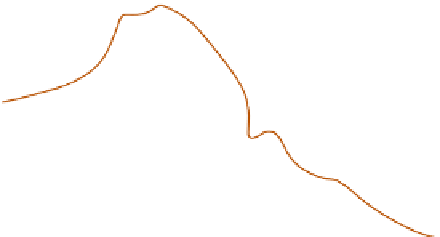Geoscience Reference
In-Depth Information
130°
140°
150°
160°
170°E
180°
170°W
Stationary front
0°
10°
20°
H
L
H
H
30°
40°
L
L
50°S
Figure 10.34
The synoptic situation at 00:00 hours on 1 September 1982, resulting in heavy rainfall in
the Southern Alps of New Zealand.
Sources: After Hessell; from Wratt et al. (1996). From Bulletin of the American Meteorological Society by permission of the
American Meteorological Society.
monthly maps, is associated with a major frontal
zone characterized by the continual passage of
depressions and ridges of higher pressure.
Throughout the Southern Ocean, this belt extends
southward from about 30°S in July and 40°S in
January (see
Figures 9.18
and
10.35B
) to the
Antarctic Trough which fluctuates between 60°
and 72
Many depressions form as waves on the inter-
anticyclonic fronts, which move southeastward
into the belt of the westerlies. Others form in the
westerlies at preferred locations such as south of
Cape Horn, and at around 45°S in the Indian
Ocean in summer and in the South Atlantic off the
South American coast and around 50°S in the
Indian Ocean in winter. The Polar Front (see
Figure 9.20
) is most closely associated with the sea
surface temperature gradient across the Antarctic
convergence, whereas the sea ice boundaries
further south are surrounded by equally cold
surface water (
Figure 10.35B
).
In the South Atlantic, depressions travel at
about 1300km/day near the northern edge of the
belt, slowing to 450-850km/day within 5-10°
latitude of the Antarctic Trough. In the Indian
Ocean, eastward velocities range from 1000 to
1300km/day in the belt 40-60
S. The Antarctic Trough is a region of
cyclonic stagnation and decay that tends to be
located furthest south at the equinoxes. Around
New Zealand, the westerly airflow at an elevation
of 3-15km in the belt 20-50
°
S persists throughout
the year. It becomes a jet stream at 150mb
(13.5km), over 25-30°S, with a velocity of 60m s
-1
in May-August, decreasing to 26m s
-1
in February.
In the Pacific, the strength of the westerlies
depends on the meridional pressure difference
between 40 and 60°S, being on average greatest all
the year south of western Australia and west of
southern Chile.
°
S, reaching
a maximum in a core at 45-50°S. Pacific
°





















































































































